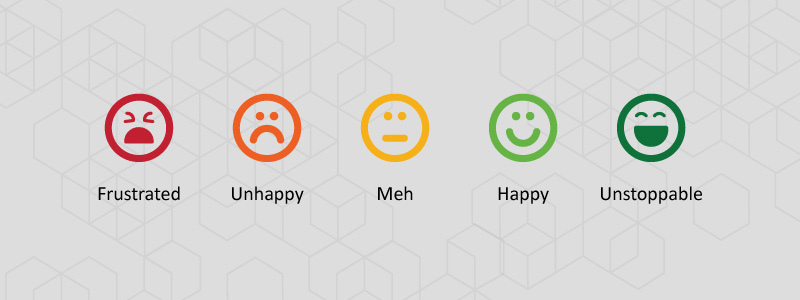Employee Mood Survey – A Fun Way To Boost Performance
Employee Mood Survey – A Fun Way To Boost Performance

Planning to run an employee mood survey? Have a huge list of questions to ask? STOP! Mood surveys don’t need to be any longer than 1 simple question – “How is your mood today?” (followed by 5 emoticons)
There is enough evidence backed by research reports which state that there is a direct correlation between the employee’s mood and his/her performance through the day.
You know how it goes: A traffic jam blocks your way to work. A rude driver swerves in front of your car and you spill that just-purchased café latte into your lap. You arrive late, in a lousy mood. From there, the day just goes downhill and your workplace performance falls to pieces.
Is there anything that you can do to change that? Probably not, but you can certainly uplift their mood from there on; making their day more productive.
Here’s how it works:
Step1:
Every morning your employees get an SMS and/or Email containing a mood-o-meter survey.
Step2:
Your employees click on the unique URL and select the emoticon that best resonates with their mood.
Step3:
You get a real-time view on the LitmusWorld dashboard with bifurcation into business units, departments, managers and so on.
How is the mood index calculated?

Well, it’s simple. The mood meter is distributed across 5 emotions:
- Frustrated (-2)
- Unhappy (-1)
- Meh (0)
- Happy (1)
- Unstoppable (2)
Each of these emotions is assigned a score on a scale of -2 to +2. A weighted average of all the ratings is then taken to represent the mood of the organization. You can further see distribution by Business Units, Departments, Managers and so on.
Spot Trends – Are things getting better or worse?
If you set up a kiosk at the entrance/exit, you can identify the mood of the organization by the hour of the day and identify trends. Is your employee morale usually getting down by the second half of the day?
A continuous employee feedback system doesn’t necessarily replace the annual employee survey, however, the advantage of getting real-time data for your employee mood is that you can easily see if things are getting better or worse.
It’s an early warning system to catch potential problems when they’re still small.
While this may seem interesting for a pilot, the real eye-opener is when you analyse this information for a larger time sample like a quarter or a year. This information is a direct indicator or the organization’s culture, employee attrition and individual performance indicators.
If you see a particular employee coming to the office for more than 7 working days with a bad mood, try intervening on a one-on-one basis to identify challenges that you can solve for. You may not be able to change things, but the gesture of intervention will show your employees that you care.
Measuring is not enough! You need to Act & Improve.

Well, through mood surveys, the idea is not to find quantifiables for your next board meeting (which you can) but the idea is to improve the organization’s culture so that your employee 9-to-5 feels like their 5-to-9. Your employees enjoy coming to work and that they build relationships and make friends at work.
Here’s where the Measure, Act & Improve framework comes at play.
You’ve measured your employee mood, great! Now, what is your plan of action to change these ratings going forward? Begin with short term-plans instead of investing in larger, more long-term improvements. Identify things that work on the fly and before you know it, you have brought about changes that seem larger than the effort and resources invested.
Set benchmarks and goals to improve this score. Don’t expect a 100% happiness score within a month or two. Remember, these scores are dependent on external factors. Try small but be incremental.
Do you want to capture your employee’s mood index? Get in touch with us and our experts will help you with the heavy lifting.

